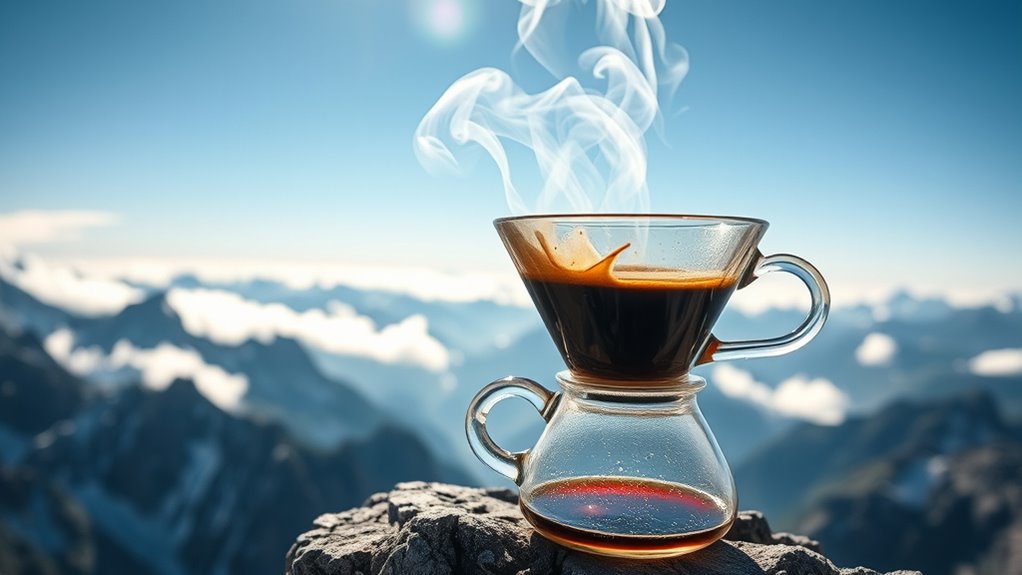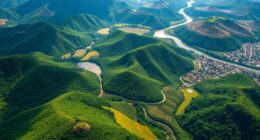At high altitudes, the lower boiling point of water means your coffee extract may be weaker if you don’t adjust. To get full flavor, try increasing your brewing time or slightly raising the temperature. Grinding your coffee finer can also help extract more quickly. Keep in mind that equipment may not hold heat well, so monitor temperatures carefully. For more tips on optimizing your brew at elevation, discover how small tweaks make a big difference.
Key Takeaways
- Higher elevations lower boiling points, which can lead to under-extraction and less flavor in coffee.
- Extend brewing time or slightly increase temperature to compensate for reduced boiling temperature at altitude.
- Use a finer grind size to maximize extraction, but be cautious of over-extraction or clogging.
- Monitor and adjust water temperature carefully, employing insulated vessels or additional heat sources if needed.
- Test and modify water chemistry to ensure proper mineral dissolution and flavor extraction despite altitude-related changes.

Brewing at altitude presents unique challenges that can considerably impact the quality of your beer. One of the most significant factors is the water boiling point, which drops as you ascend in elevation. At sea level, water boils at 212°F (100°C), but at higher altitudes, it boils at a lower temperature. This means your water may not reach the same temperature needed for ideal extraction during brewing. If you don’t account for this, your mash and boil process can be compromised, leading to under-extraction and a less flavorful beer. To counteract this, you might need to adjust your process by increasing your boiling time or slightly increasing the temperature to guarantee proper dissolution of grains and hops.
Another critical adjustment involves grind size. Because water boils at a lower temperature, the extraction rate slows down, and the finer your grind, the better your chances of compensating for this reduced temperature. You’ll want to experiment with a slightly finer grind than usual, which helps maximize surface area and promotes better extraction despite the lower boiling point. However, be cautious—going too fine can cause over-extraction or clogging, so it’s essential to find the right balance. Monitoring your process closely and making incremental adjustments will help you fine-tune your brew for altitude conditions.
Temperature control is also trickier at higher elevations because your equipment may not hold heat as efficiently, and ambient temperatures can fluctuate more dramatically. Using a thermometer to keep tabs on your mash and boil temperatures becomes even more essential. You might need to extend your mash time or increase your heat source slightly to maintain the desired temperature. In addition, consider using insulated or heated vessels to help stabilize temperatures during the brewing process.
Water chemistry plays a critical role too. Since the boiling point affects how minerals and other components dissolve into your water, you should test and adjust your water profile accordingly. Softening or mineral additions can help optimize water for brewing at altitude, ensuring better flavor extraction and consistency.
Frequently Asked Questions
How Does Altitude Impact Coffee Bean Flavor Profiles?
You might notice that altitude flavor influences your coffee’s taste, as higher elevations bring out unique flavor profiles. Elevation nuances like brighter acidity and more complex aroma develop because beans grow slower at higher altitudes, allowing richer flavors to emerge. When you brew coffee at different elevations, you’ll see how altitude affects the overall flavor, giving each cup a distinctive character that’s tied to its specific elevation.
Should I Adjust My Coffee Grind Size at High Elevations?
Ever wondered if your grind size adjustments are enough for high elevations? The altitude influence means water boils at a lower temperature, so you might need to tweak your grind size—usually making it slightly coarser—to guarantee proper extraction. Adjusting your grind size at high elevations helps optimize flavor and prevents over-extraction. Remember, small changes can make a big difference in brewing success when altitude influences your coffee’s taste.
Does Water Boiling Point Change Significantly at Various Altitudes?
You might wonder if boiling point variations at different altitudes impact your brewing. As you go higher, altitude effects cause water to boil at lower temperatures, often below 100°C (212°F). This change can influence extraction, meaning you may need to adjust your brewing process. Understanding these altitude effects helps you optimize your coffee, ensuring you get the best flavor even as boiling points shift with elevation.
Are There Specific Brewing Methods Better Suited for High-Altitude Coffee?
You might think all brewing methods work the same at high altitude, but altitude adjustments are essential. To get the best flavor, try brewing techniques like using a slightly longer steep time or increasing grind size. These adjustments help compensate for lower boiling points and quicker extraction. Experimenting with altitude-specific brewing techniques ensures your coffee remains rich and balanced, even when elevation challenges your usual routine.
How Can I Prevent Under-Extraction or Over-Extraction at High Elevations?
To prevent under-extraction or over-extraction at high elevations, you should focus on altitude calibration and extraction consistency. Adjust your grind size to be slightly finer to compensate for faster brewing times, ensuring proper extraction. Keep track of your parameters and make small, incremental changes. By being mindful of altitude effects and maintaining consistent brewing practices, you’ll achieve better flavor and balance in every cup.
Conclusion
Brewing at altitude changes how your coffee turns out, but with a few tweaks, you can still enjoy a perfect cup. Did you know that water boils at lower temperatures as elevation increases? For every 500-foot climb, boiling point drops about 1°F, meaning you might need to adjust your brewing time. Embrace these quirks, experiment, and you’ll discover that great coffee at high altitudes is totally achievable—just a little different from at sea level.









